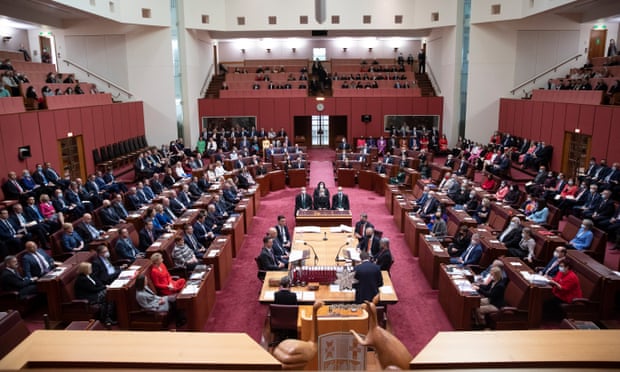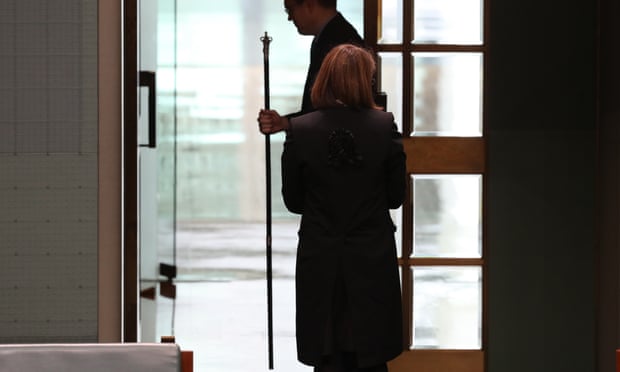Extract from The Guardian
What is the difference between the house and the Senate? Who is the Speaker of the House? What are backbenchers? Here’s our guide to the key terms and processes.

Thu 28 Jul 2022 03.30 AEST
Last modified on Thu 28 Jul 2022 03.32 AESTWhat happens during a parliamentary sitting?
A parliamentary sitting is when the whole parliament – the government, opposition, minor parties and independents – come together to debate and pass laws. Parliament sits for about 20 weeks a year.
Sitting days are bound by rules set out in what are known as “standing orders”.
The day starts with government business, which is when planned issues or proposed laws are presented and debated. Members then give statements to parliament until 2pm, when question time starts. Question time is the liveliest part of the day, when parliamentarians take questions from their opposing members, but also from their own party (this is called a “Dorothy Dixer”, see below).
After QT is the presentation of documents. Then comes the matters of public importance: a discussion on one issue, usually brought up by the opposition, criticising how the government is doing something.
After that are prepared statements from any ministers who want to speak, and finally the day ends on more government business.

What is the difference between the House and Senate?
The Senate has red seats and carpet, with 76 senators that represent states and territories. The House of Representatives has green seats and carpet, with 151 members that each represent an electorate.
Bills (AKA legislation) usually originate in the House of Representatives. To become law, they have to pass a vote in both the house and the Senate.
What does it mean when standing orders are ‘suspended’?
It is not unusual for the house or Senate to suspend a standing order – ie to press pause on one of those rules governing how they operate. This is so they can do something that would otherwise not be allowed: for example, introduce a proposed law that has not been scheduled for debate, or discuss new business after a sitting day has ended.
More than half (an absolute majority) of the house or Senate needs to vote in favour of a motion to suspend.
Is there a code of conduct for parliamentarians?
There is, and it covers things like using “objectionable words” or disregarding the authority of the speaker. A “disorderly” member can be told to leave the debate for an hour by the Speaker.
This mostly happens during question time, which is the shoutiest part of the sitting day.
How long can an MP absent themselves from parliamentary sittings?
There is no limit to the amount of leave an MP can take.
Why are prayers read before parliament, in a secular nation?
Good question! Each sitting of the parliament has begun with a prayer in both chambers since federation in 1901, and it is mostly because of tradition – the UK and other common law parliaments, like Canada, also begin parliamentary sittings with this tradition.
In Australia, the prayers are part of the standing orders, so in order to be changed, there would have to be an amendment to the standing orders. Attempts to do this in the past (and replace prayers with a moment of prayer or reflection) have failed. In 2010, the standing orders were changed to add an acknowledgment of country before the reading of prayers.
Who is the Speaker of the House?
Over in the senate, that role is played by the president.
The speaker is chosen in a secret vote after the official opening of parliament. You may have seen the speaker “dragged” to the chair after they are appointed to the position. Not in the “drag them” sense, but the successful nominee does pretend to be quite reluctant about taking up the role.
The parliament website describes it thusly:
The custom had its origin in the genuine reluctance with which early Speakers accepted the office, for the role of spokesman for an emerging body of legislators bent on opposing the royal will was a dangerous occupation.
What are backbenchers?
Our parliament has both frontbenchers and backbenchers. If you imagine the layout of the House of Representatives, the front row of seats facing the speaker are where the ministers (frontbenchers) sit, and the backbenchers sit behind them.
Backbenchers are members of parliament who are not ministers or shadow ministers. They represent and advocate for their electorates and debate and vote on proposed laws.
Without their votes, governments can’t pass legislation in the house. In the Liberal party, where MPs can vote against legislation without ramifications, this theoretically gives them a lot of power. For Labor, voting against a caucus decision means expulsion from party, so it is a little more tricky for them.
What are committees?
Parliament can appoint a group of up to 10 members of parliament to investigate specific issues or proposed laws. This is a select parliamentary committee.
The committee invites submissions on the issue from experts, interest groups and the community. They also hold public hearings where they can hear directly from these groups. Their findings are reported back to the house.
The parliament considers the committee’s findings, but it doesn’t mean it will adopt them.
What on earth does ‘I move that the member be no longer heard’ mean?
In the previous parliament, the former government would “move the member no longer be heard” almost every time there was a motion to suspend standing orders, which Labor argued was shutting down debate. It will be interesting to see how Labor handles these interruptions to the schedule.
What is question time?
Each parliamentary day includes a dedicated “question time”, when all the members are present in the chamber and, usually, the most topical, challenging and controversial conversations are had.
Question time is usually held for an hour, but it is at the prime minister’s pleasure, meaning it is the PM who calls time on it. That can be abused when it suits the government. Malcolm Turnbull once allowed question time to keep going and going as his government tried to run down the clock on a medevac bill vote it didn’t want held. Scott Morrison would cut QT short when there was an issue he didn’t like being prosecuted by the Labor shadow ministers.
What does it mean when a question is ‘put on notice’?
Sometimes a minister is asked a question that they cannot or do not want to answer. The question is then “taken on notice”, and will be responded to later in writing.
The answer, once prepared, is always available on the parliament’s public record.
Is that different from ‘questions on notice’?
Yes! There is a difference between a question being “put on notice” and “questions on notice”. Questions on notice are written questions to a minister from a member of parliament, usually asking for detailed information. The answers are also published.
Why is everyone talking about Dorothy Dixers?
A Dorothy Dixer is a question planted by a government minister and asked by a backbencher of their own political party during question time. The dixer tactic has a few goals: to give free publicity to the government, to help the minister speaking look good, to make the opposition look bad, to raise the profile of the backbencher asking the question, or to waste the available question time to avoid harder questions.
So … who is Dorothy Dix?
She was an American advice columnist who was known to make up and submit her own questions so she was able to publish more interesting answers in her columns.
This article includes content provided by TikTok. We ask for your permission before anything is loaded, as they may be using cookies and other technologies. To view this content, click 'Allow and continue'.
What are green papers?
A green paper is a government document that goes through details of specific issues, and outlines potential policy and legislation changes for those issues (for example, a green paper about the issue of an ageing population and the potential for a new aged care system).
A green paper doesn’t actually commit to any action or change. Instead, it is to prompt discussion, and acts like a first step towards changing the law.
What about the white ones?
After a green paper is published, the government consults the public for their thoughts and feedback. From those discussions, a white paper is born.
White papers are documents with actual legislative intention, proposing change to policy or law. They are sometimes debated before a bill is produced.
What is a bill?
A bill is basically a proposal for a new law, or a change to an existing law.
A bill is first introduced into either the House of Representatives or Senate, and has to be passed by a majority vote in both chambers.
If successful, it is signed by the governor general – this is the royal assent, and is the last step before the bill becomes law. Then the bill is known as an Act of Parliament, which will give a date that the new law will begin.
Sounds simple enough, but it can take years for a bill to pass through parliament.
What is a maiden speech?
The first speech given by a newly elected member of parliament is sometimes referred to as a maiden speech.
Technically, Australia’s parliament doesn’t really use the term “maiden speech” any more. (On the parliamentary website they are just called “first” speeches.) But colloquially, the term is still used.
What is a conscience vote?
A conscience vote allows members of parliament to vote according to their personal beliefs rather than along party lines.
These votes are usually used for social issues like abortion and euthanasia.
What is that ominous Black Rod?
You might have seen a rod made of ebony with a silver crown that is carried around in the Senate. It is a ceremonial object carried by the Usher of the Black Rod while doing things like escorting the President of the Senate into and out of the Senate and delivering messages or bills to the House of Representatives.
The Usher of the Black Rod is a tradition that dates back to the 1500s in Britain. They served the British House of Lords, and were an officer of a British order of Knighthood called the Most Noble Order of the Garter. If someone offended the order, the Black Rod itself was used to discipline them! (Thankfully, that tradition is long gone.)
Why is the Liberal party called the Liberal party?
The word “liberal” is commonly understood to mean progressive, so it’s confusing that Australia’s major conservative party uses the name.
The word actually comes from the Latin word “liber”, which means free. In Australia, our Liberal party is more aligned with economic liberalism, or freedom for business.
The Australian Liberal party developed out of conservative parties that formed in the early 20th century to oppose the growing strength of trade unions and the Labor party.
Here is what Robert Menzies, the father of the Liberal party, had to say about it:… what we must look for, and it is a matter of desperate importance to our society, is a true revival of liberal thought which will work for social justice and security, for national power and national progress, and for the full development of the individual citizen, though not through the dull and deadening process of socialism.
And a fun fact about picfacs
Short for picture facility, picfac is an Australian phrase (at least according to the Oxford Dictionary) for a photo opportunity and has been in use since the 1990s. Of course, politicians have been pretending to hold conversations for the cameras for much longer than tha
No comments:
Post a Comment